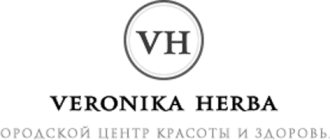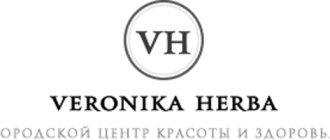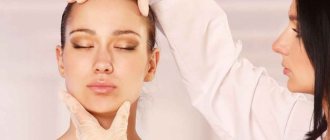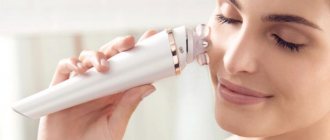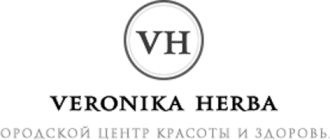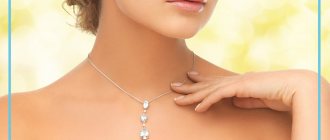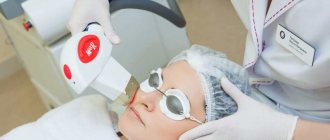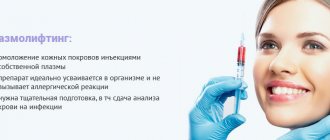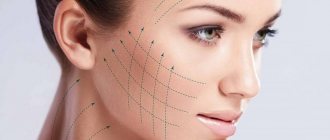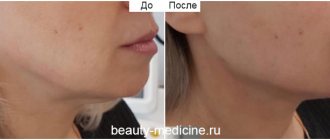How does photorejuvenation work?
The essence of this rejuvenation method is based on the action of a special cosmetology device that creates a light beam of a certain frequency. The specialist independently adjusts the wavelength of radiation, depending on the condition of the patient’s skin.
There are several methods and types of photorejuvenation. The doctor selects individually which device can best cope with the patient’s skin problems.
- Laser photorejuvenation is considered one of the most effective; a neodymium laser is used here.
- IPL – this technique uses fairly intense pulses of light. The skin is exposed to frequent flashes of radiation of a given intensity.
- Elos photo-rejuvenation - a device is used here that combines electro- and photo-rejuvenation of the face; it emits light of electrical origin.
- Collagen photorejuvenation is performed using collagen lamps. Unlike elos rejuvenation, they affect the skin with light rays of a certain length.
Photorejuvenation helps patients with various skin problems. Indications for this type of rejuvenation include:
- dark spots;
- expression wrinkles;
- gray skin tone;
- signs of skin aging: sagging, sagging tissue, the appearance of jowls and a double chin;
- rosacea;
- enlarged and contaminated pores;
- increased skin oiliness.
The photorejuvenation procedure takes place in several stages. In order for the patient to be calm and know what will be done with him, it is worth knowing in advance how this type of rejuvenation is carried out.
1. Cleansing the skin and applying gel for cooling and better contact between the skin and the light pulse;
2. The patient wears special glasses to protect his eyes;
3. The rejuvenation procedure itself begins, the specialist applies the device to the treatment area and a photo flash is fired, with rays of a certain length. So the doctor goes around each area on the face. The procedure itself lasts from 15 to 60 minutes, depending on the area being treated.
4. At the end of the session, the doctor treats the skin with an anti-inflammatory and hypoallergenic gel, which helps soothe the skin and maintain the effect of the procedure.
As a rule, redness is visible on the skin immediately after the procedure. However, it goes away after a few hours. Thus, the rehabilitation period after each procedure is quite short. But visible changes can be noticed within 10-14 days after the first visit to the doctor. According to patient reviews, they noticed that, unlike conventional anti-aging procedures, after the first visit to photorejuvenation, the skin becomes smoother, tightened, and small wrinkles are smoothed out. The doctor decides how many photorejuvenation sessions are required. He assesses the condition of the skin, looks at the reaction after the procedures and calculates how many visits will be necessary. Plus, the patient himself notices a significant difference in the condition of his skin.
Each patient should familiarize themselves with the contraindications before undergoing one or another photorejuvenation procedure. And inform your doctor about their presence. So, photorejuvenation is not performed when:
- the presence of tumors in the body;
- hypertension;
- pregnancy;
- blood diseases;
- inflammatory processes on the skin;
- diabetes mellitus;
- presence of pacemakers;
- diseases of the thyroid gland.
Preparing the device before use
Preparing the apparatus - make sure that distilled water is in the apparatus
Turn on the device through a voltage stabilizer.
Treat the tip of the laser handpiece with medical alcohol.
Prepare safety glasses for the client and specialist
Prepare consumables - transparent ultrasonic gel of medium viscosity, a spatula and the necessary disposable consumables.
It is necessary to prepare the client's skin for exposure - cleansing with an antiseptic without alcohol.
Setting parameters for rejuvenation - light power and radiation frequency.
Step 3
.
Laser rejuvenation: what is it?
Modern developments by scientists in the field of skin rejuvenation have made it possible to make a big breakthrough. Rejuvenation is becoming safer and faster, as evidenced by the results of laser rejuvenation procedures using a fractional CO2 laser.
The essence of this technique is selective influence. The beams form a laser lattice, the radiation evaporates small areas of the skin. Each of the finest rays creates a depression in the skin, a fraction, to a certain depth. There is a uniform alternation of evaporated zones with untouched ones. In turn, the areas that remain untouched have a healing effect on the damaged areas. By contracting and regenerating, they create a good lifting effect.
.
There are several varieties of this procedure. Laser rejuvenation can be performed using two methods:
— Ablative is a targeted laser effect that evaporates the upper cells of the epidermis, penetrating a maximum of 1.5 mm under the skin. During the procedure, superficial areas of the skin are removed. This method is best suited for the first signs of aging.
- Non-ablative - this method, on the contrary, has a deeper effect on the skin. The beam can penetrate to a depth of 5 mm. Thus, the laser helps cells build a new membrane frame and renew themselves from the inside. All processes are activated, the production of collagen and elastin. This solves the problems of skin aging and visible changes, tightens the oval of the face and improves skin color. The skin receives maximum healing and rejuvenating effect, both from the inside and outside.
Indications for laser facial rejuvenation include:
- acne and post-acne;
- significant photoaging of the skin;
- deep expression wrinkles;
- poor skin condition;
- sagging and sagging;
- pigmentation;
- enlarged pores.
The whole procedure is divided into several important stages, which should include:
1. Makeup removal and pain relief in areas of particular sensitivity.
2. After 20 minutes, when the skin is no longer sensitive, the doctor begins laser treatment. The session can last up to 60 minutes. The exact amount of time depends on the scope of work and zones.
3. After laser treatment, the doctor applies products with dexpanthenol to the skin for speedy healing and tissue restoration. In the first two hours after the procedure, swelling, pain and redness are observed in the treated areas.
Redness and swelling may persist for 2 days. Next, crusts will appear on the skin; they can last from 3 to 10 days, depending on the depth of the effect. Experts recommend lubricating the skin well with soothing agents: Bepanten, Panthenol, D-panthenol, as well as creams with hyaluronic acid. In 2-3 weeks the crusts will disappear and you can sign up for a new procedure.
Typically, a laser rejuvenation course consists of 3-5 sessions, depending on the problems the patient has addressed. Three months after the last procedure, the maximum effect of rejuvenation can be observed. To maintain results, it is recommended to undergo 1-2 preventive procedures per year. Which will help against rapid skin aging and give minus 5-6 years.
Laser rejuvenation is considered the most gentle method, there are no side effects, and the rehabilitation period lasts only 7-10 days. Despite the accessibility and effectiveness of the procedure, anyone who wants to undergo laser rejuvenation should first familiarize themselves with the contraindications and be sure to notify the doctor about the presence of any ailments before starting the procedures.
So, laser rejuvenation is not recommended for:
- open skin diseases, including herpes;
- psoriasis, dermatosis;
- the presence of infections in the body;
- wounds at the treatment site;
- pregnancy and breastfeeding;
- immune diseases;
- diabetes mellitus;
- ischemic disease.
Are there possible consequences after the procedure?
Side effects after laser skin rejuvenation are possible, but observed quite rarely:
- Mild itching occurs.
- Formation of red spots in the laser impact area.
- Activation of the herpes virus.
- Violation of the integrity of the skin: peeling, minor burns, crust formation.
It is worth remembering that after laser rejuvenation you will not necessarily notice any of the listed symptoms. If they happen, they will pass in a few days. For most patients, everything goes away without consequences. It depends on the sensitivity of the skin and its structure.
Approximately 4% of patients experience negative consequences, such as:
- Skin prone to seborrhea becomes covered with whiteheads (milia).
- After the procedure, scars or keloids remain.
- Skin hyperpigmentation.
- Exacerbation of herpes and activation of its rashes (despite the prevention).
Photorejuvenation or laser rejuvenation: which is better?
Let's summarize what to choose for rejuvenation: photo procedures or laser?
Photorejuvenation is suitable for patients aged 30 to 55 years. Ideally copes with age spots, dilated blood vessels and pores. Also good for removing fine and superficial wrinkles.
In contrast, laser rejuvenation is suitable for patients over 45-50 years old. Because laser copes better with deeper skin rejuvenation and has a pronounced lifting effect. Fractional CO2 lasers help remove moderate to deep expression lines.
Such procedures can easily replace both plastic surgery and other methods of rejuvenation and facelift.
However, to accurately determine which procedure is right for you, it is best to consult with a cosmetologist. At the Lazmed Clinic, both rejuvenation methods are used; our highly qualified doctors will be able to choose the best rejuvenation method for the individual characteristics of the skin.
Machine operating settings
The diode device has a special program for rejuvenating the skin of the face and body, which has almost automatic settings.
Radiation frequency in rejuvenation mode is 10 Hz and maximum power is 5 J.
Rejuvenation occurs due to the absorption of infrared light with a wavelength of 808 nm by the skin. In the skin, light gently warms collagen fibers, which become more elastic, and the skin acquires tone. This effect is observed even when performing hair removal or taking an infrared sauna.
In parallel with rejuvenation, an anti-inflammatory effect is observed, therefore diode rejuvenation is indicated for adult clients suffering from post-acne pigmentation.
Let's move on.
Step 4
.
Who needs it?
Indications for the use of a modern device are the need to:
- removal of vascular unwanted formations.
- even out skin color and photorejuvenation.
- improving muscle tone of the body.
- complex application in dentistry.
- therapeutic effect on problem areas of the face that are covered with acne (acne disease). Laser rejuvenation 808 nm
A cosmetologist cleanses the patient’s skin and treats it with anesthetic ointment. Then onto the area of skin that will be subjected to laser treatment. A special gel is applied to gently glide the laser tip over the skin. It ensures a comfortable feeling for the patient during the entire procedure. Both during the procedure of fractional laser rejuvenation and when eliminating scars. The gel can also be replaced with an anesthetic - lidocaine. Within a few minutes, but no more than 1 hour. The cosmetologist smoothly moves the nozzle over the treated area of skin. Laser rejuvenation 808 nm narrows enlarged pores and strengthens vascular walls.
Laser Laser rejuvenation
Possible consequences of laser hair removal
Let’s make a reservation right away: complications after laser hair removal occur in three cases:
- the cosmetologist and his client ignored contraindications;
- errors were made during laser processing - incorrectly selected light wavelength, energy density, pulse duration, lack of cooling, etc.;
- laser equipment of dubious quality was used.
When faced with these problems, negative consequences cannot be avoided. Most often, girls complain of complications such as:
- burns;
- age spots or, on the contrary, “burnout” of skin pigment;
- formation of scar tissue;
- allergic rashes;
- soreness and increased sensitivity of the skin in the treated area;
- hematomas;
- folliculitis;
- active growth of vellus hair;
- development of photophobia and vision problems;
- exacerbation of herpes, chronic diseases, etc.
Of course, without being an expert in the field of laser hair removal and having resorted to the procedure for the first time, it is impossible to assess the quality of the device, the competence and correctness of the cosmetologist’s actions. Therefore, along with the question of why laser hair removal is dangerous, you need to ask another, no less important question - is it dangerous to do it in this particular beauty salon or clinic.
To answer it, you need to study reviews about the organization and the doctors working in it. There is no need to ignore a preliminary consultation with them, because during casual communication you can assess the competence of a specialist: if he is not interested in contraindications, does not warn about side effects, does not give recommendations for caring for the treated area and promises “mountains of gold”, then you should not trust him "cosmetologist".
How often is hair removal done and is it possible to permanently remove hair with laser?
The statement that laser hair removal eliminates hair forever is often misunderstood. From a medical point of view, complete hair loss implies a temporary or permanent cessation of hair growth. Laser hair removal allows you to achieve complete, temporary hair loss with the possibility of partial, long-term reduction in their number.
This formulation sounds rather confusing and incomprehensible, but in fact it means that after using the laser, hair does not grow for a long time, and when its growth resumes, it becomes very sparse and inconspicuous. Understanding this point is extremely important when setting expectations for laser hair removal. Otherwise, disappointment from the procedure cannot be avoided.
As for the frequency of treatments, it is purely individual - adequate to the speed of hair regrowth. On average, to achieve a sustainable result of complete hair loss, problem areas are treated once every 4 to 6 weeks. After which maintenance procedures are carried out - once every 12 - 24 months.
